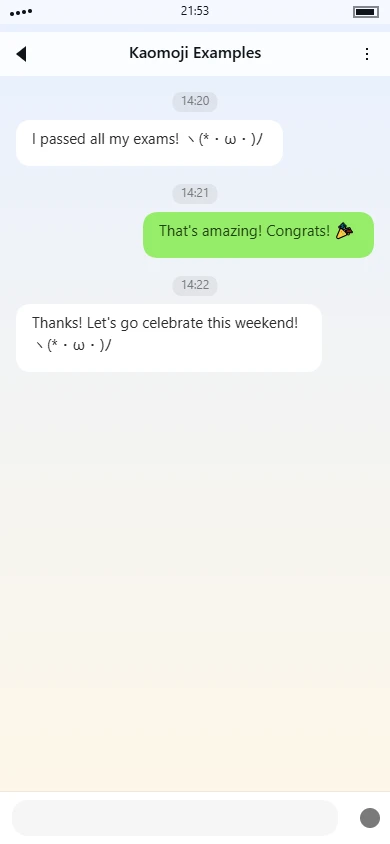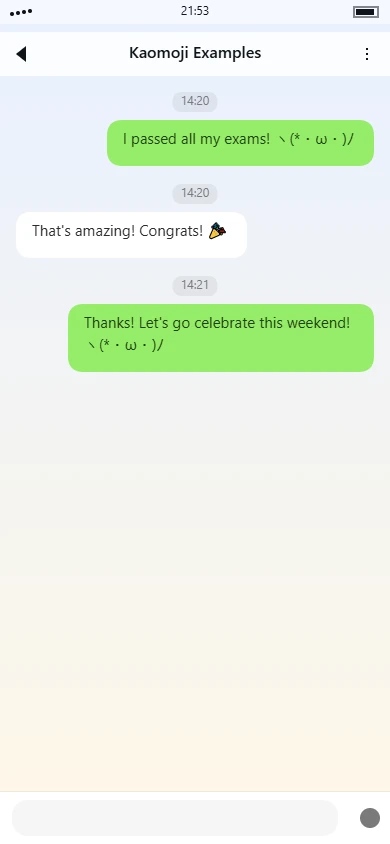( ̄▽ ̄) kaomoji meaning | usage tips

Overview
The kaomoji
( ̄▽ ̄)Symbol Breakdown
- Parentheses
: These fullwidth brackets frame the entire expression, creating a rounded face shape that gives the impression of a complete head or face outline( ) - Eyes
: The two macron characters function as closed or slightly squinted eyes, suggesting a relaxed, content expression rather than wide-eyed excitement ̄  ̄ - Mouth
: The downward-pointing triangle forms a distinctive mouth shape that resembles a gentle smile or content grin, with the upward-curving sides contributing to the positive expression▽
Emotion & Aesthetic Analysis
The overall expression conveys a sense of calm satisfaction or mild amusement. The closed eyes suggest comfort and relaxation rather than intense emotion, while the triangular mouth maintains a positive but understated smiling quality. This kaomoji occupies a middle ground between neutral and happy expressions - it's not as exuberant as kaomoji with wide-open eyes or exaggerated smiles, but clearly conveys contentment.
In practical usage,
( ̄▽ ̄)Tag categories
Use tags to quickly understand this kaomoji.
Usage guide
Usage Guide for ( ̄▽ ̄)
The kaomoji ( ̄▽ ̄) is one of the most versatile and widely recognized Japanese-style emoticons in online communication. It depicts a simple, contented face with upward-curving eyes and a gentle smile, conveying a range of positive emotions from mild satisfaction to playful mischief. This emoticon is particularly popular in casual digital conversations, gaming chats, social media comments, and friend group messages where a lighthearted, friendly tone is appropriate. Its balanced expression makes it suitable for expressing agreement, gentle teasing, self-satisfaction, or simply maintaining a cheerful atmosphere without being overly enthusiastic.
Common Use Cases
- When agreeing with a friend's suggestion for weekend plans
- Responding to a funny meme in a group chat
- Expressing quiet confidence after solving a difficult problem
- Reacting to good news from a colleague in a casual work chat
- Acknowledging a clever joke without using loud laughter
- Showing peaceful acceptance of an unavoidable situation
- Playfully teasing a friend about a minor mistake
- Celebrating a small personal achievement in a humble way
- Responding to food pictures in social media comments
- Expressing contented anticipation for an upcoming event
- Softening a potentially critical comment with friendly tone
- Wrapping up a conversation on a positive note
Example Conversations
-
Friend chat about movies
A: Just finished that series you recommended B: And? What did you think? A: ( ̄▽ ̄) it was exactly my taste, thanks!
-
Gaming session coordination
A: I think I figured out the boss pattern B: Really? Share the wisdom! A: ( ̄▽ ̄) let me show you in the next round
-
Workplace casual message
A: The client approved our proposal B: That's great news! A: ( ̄▽ ̄) knew they'd come around eventually
-
Social media interaction
Post: Finally got that promotion! Comment: ( ̄▽ ̄) well deserved, congrats!
-
Everyday conversation
A: Your cooking keeps getting better B: ( ̄▽ ̄) been practicing new recipes
-
Planning discussion
A: Should we meet at 6 or 7? B: Either works for me A: ( ̄▽ ̄) let's do 6 then
Important Notes
- Avoid using this emoticon in formal business emails, official communications, or serious discussions where a professional tone is required
- While generally positive, the subtle smile can sometimes be misinterpreted as sarcasm or passive-aggression in certain contexts, especially when discussing sensitive topics
- The expression's mild nature means it might not convey strong enthusiasm for major achievements or exciting news - consider using more expressive emoticons for those situations
This kaomoji works particularly well in text-based communication where vocal tone and facial expressions are absent, helping to maintain a friendly atmosphere. Its popularity across various online platforms from Discord to Twitter makes it universally recognizable, though the exact interpretation might vary slightly between different online communities.
Usage examples
Real conversation samples that feature this kaomoji.

Example 1

Example 2
Related kaomoji
You might also enjoy these kaomoji.